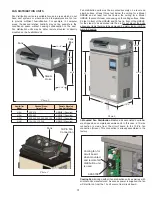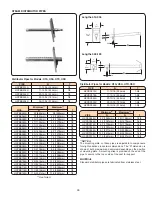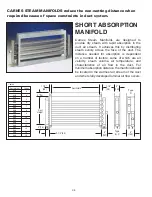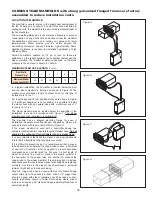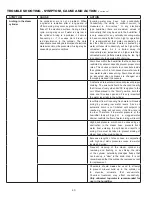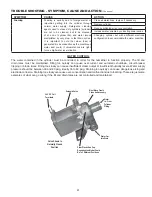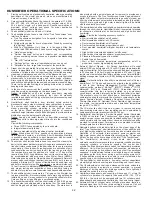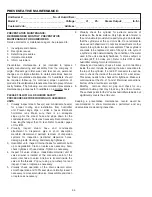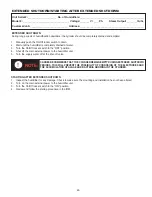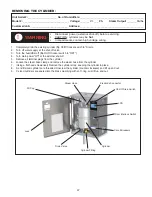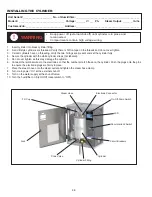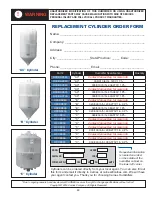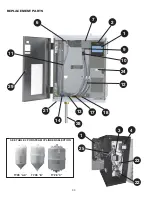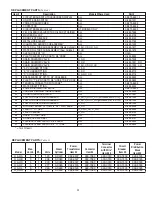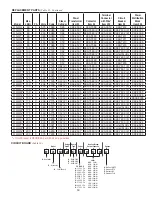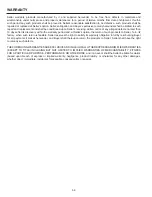
44
PREVENTATIVE MAINTENANCE:
Unit Serial #: _____________________ No. of Humidi
fi
ers: ______________________________________________
Model #: _________________________________ Voltage: _______ V/ ___ Ph.
Steam Output: _______ lb./hr.
Customer/Job: ___________________________ Address: ______________________________________________
PREVENTATIVE MAINTENANCE:
RECOMMENDED MONTHLY PREVENTATIVE
MAINTENANCE FOR HUMIDIFIERS
Service contractor or maintenance agent - be prepared to:
1. Investigate and observe.
2. Recognize
issues.
3. Determine
procedures.
4. Implement
solutions.
5. Inform
customers.
Preventative maintenance is not intended to replace
quality manufacturing and assembly from the company of
origin. Products get older, wear and tear occurs, personnel
changes and simple attention to detail sometimes become
lax. Basic preventative maintenance for humidifiers should
be required follow-up for continued proper operation of
products. Preventative maintenance is a means to prevent future
costly failures. The following are recommended preventative
maintenance procedures for humidifiers on a monthly basis:
PLEASE FOLLOW ALL REQUIRED SAFETY
PROCEDURES BEFORE WORKING ON HUMIDIFIER
UNITS.
1. Visually inspect steam hose(s) and condensate hose(s)
for proper routing and installation from humidifier
unit. Prevent sags, dips, or kinks in hoses. Eliminate
horizontal runs. Make sure there is an adequate
slope up for the steam hose and slope down for the
condensate return. Correct as necessary. Recommend no
hose lengths longer than 10 feet. Refer to earlier pages
of this IOM.
2. Visually inspect steam hose and condensate
attachment to dispersion pipe or short absorption
manifold. Recommend periodic removal of dispersion
systems for inspection (restricted dispersion holes,
damage, plumb mounting, and clamping tightness).
3. Humidifier unit - inspect internal hoses for sediment build
up or degradation. Clean or replace as necessary. Also,
check tightness of hose clamps. Tighten as necessary.
4. Inspect fill valve strainer. Industrial/commercial unit fill
valve strainer is located at the connection point of the
water inlet hose to valve. Strainer is located inside the
valve at the threads. Pop out using a non-sharp tool and
inspect. Clean or replace as necessary.
5. Visually check operation of the drain solenoid valve,
smooth operation and 100% seal when normally closed. If
necessary, remove solenoid valve, disassemble and clean
or replace as necessary.
6. Visually check the cylinder for extreme amounts of
residue on the inside surface. Very high levels of water or
the unit unable to provide full capacity may be an indication
that the cylinder is at the end of its life. Do not attempt to
clean out with chemicals; do not stick screwdrivers or other
objects into cylinder to clean out sediment. These cylinders
are made to be replaced at end of life cycle. Life cycle of
a cylinder is often determined by the condition of the water
used in the unit, especially hardness, % of max output, or
run time (24/7, 8 hr./day, etc.). Refer to this IOM or main
humidifier catalog for more information.
7. Visually and manually check all wires and connections
inside the unit. Include inspecting the wire connections to
the top of the cylinder. If a red 90° connector is used, be
sure to check the inside of the connector for a set screw.
This screw needs to be checked for tightness. Make sure
control wires at the J16, J17 and J18 terminal connections,
bottom of the circuit board, are tight.
8. Monthly - remove drain air gap and check for any
sediment buildup that may block any free flow of water.
These check points for the “H” series humidifier are basic, but
significantly covers the entire unit.
Keeping a preventative maintenance record would be
recommended to show maintenance performed and any
observations made during inspection.


